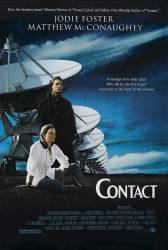Question: If you read the book version of Contact you know that the stuff about transcendental numbers and the Artist's Signature was left out of the movie. This makes no sense to me, since it's not only the real ending, it's the whole POINT of the story. Without this information, the story's fundamental question (does God exist?) is not answered in the movie. Does anyone know why this was left out?
Answer: The film chooses to focus on Ellie's personal journey and how she deals with and comes to terms with what happens - it doesn't really involve God at all, other than the inclusion of Palmer Joss as a religious advocate, choosing to restrict itself to the much less theologically controversial theme of a straight first contact scenario, without the religious overtones. Given the depth of feeling on religious matters in the US, it's hardly surprising that the filmmakers preferred to leave this particular hot topic out. While Carl Sagan died during production of the film, he both co-produced and was involved in the story process, so he was clearly not concerned about this change.
Question: In the few seconds (Earth time) it took for the pod to fall through the time travel device, it would have been impossible for Ellie to have become detached from the safety seat. It would have been even less possible for the seat to have become dislodged from the pod, AND for the seat to smash against the side of the pod with sufficient force crush it. I understand there was a cover-up (e.g., the 18 hours of static on her recording device), but Ellie, herself, would have remembered the dislodged, smashed seat. Why did she never bring it up in defense of her version of the facts? Was there a reason someone knows of, or is this just a plot hole?
Chosen answer: Ellie defended her version of the facts with everything she had to work with, but the simple fact was that the government cover-up was just too strong for her to overcome. The points you raise are perfectly reasonable, but the version of events released by the powers-that-be denies everything that happened and, without any other proof, Ellie has only her word to convince people with. For some, that's enough, as we see in the film, even if a majority choose to believe the "official" version.
Question: What type of ring are Ellie and her father wearing? It looks like other cast members are wearing a blue ring as well and both of them have the rings on when her father holds her hand.
Answer: The ring looks like sterling silver with a semi-precious Lapis Lazuli stone (not terribly expensive, even today). The name Lapis Lazuli literally translates (from Latin and Persian) to "Stone of the Sky," which probably explains Ellie and her father wearing the rings. Her father always encouraged her interest in astronomy and radio communications, and she spent much of her career waiting for "a voice from the sky" (as is also mentioned in the movie's dialogue). Other characters in the movie wearing replicas of Ellie's ring could be interpreted as their support for Ellie unravelling the alien message and going on the space mission. Another interpretation could be that the blue-stoned rings in the film are a tribute to astronomer and author Carl Sagan, who famously described the Earth as a "blue dot" decades ago. Sagan, who wrote "Contact" and consulted on this film, died during the movie's production.
Question: How did they film the scenes where real historical figures (President Clinton, for instance) made speeches and comments they didn't make in real life?
Answer: They used real footage and used careful editing to make it appear as if they were talking about the events of the film.






Answer: If anything, I think the film's producers deliberately left godly topics unaddressed (and questions dangling, unanswered) because they didn't want to alienate any particular audience. However, we know the producers of "Contact" certainly did vilify religion through the sinister scenes with Joseph, the evangelical extremist. At the same time, the film created empathy for the president's glib theological adviser, Palmer Joss. So, I don't think the film was shying away from religious topics, and I think it was pretty fair to the religious viewpoint, for the most part. But this movie wasn't about religion; it was about a primitive, materialistic, self-centered and aggressive species (humanity) reluctantly acknowledging the existence of vastly more intelligent and even godlike entities throughout the cosmos. Even the first-contact entities, advanced as they are, acknowledge other entities much more ancient and much more advanced (the virtual architects of the space/time conduit). The implication was that we live in a universe that may be populated with many intelligent entities that answer every human criteria of godhood. Ellie's narrow-minded atheism was surely shaken to its foundation by her experience; and, while she didn't "convert" to archaic earthly religions, she was spiritually a different person upon her return. The film, however, is open-ended and fence-straddling and doesn't presume to definitively answer the question of the existence of god, leaving it up to the audience to decide.
Charles Austin Miller